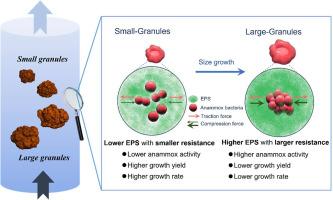Mechanical resistance of higher EPS contents in larger granules restricts anammox bacterial growth
IF 12.4
1区 环境科学与生态学
Q1 ENGINEERING, ENVIRONMENTAL
引用次数: 0
Abstract
Extracellular polymeric substances (EPS) are core granular components, playing critical roles in its structural stability. However, little is known about the effect of EPS on bacterial growth due to physical and mechanical resistances posed by EPS matrix. Herein, anaerobic ammonium oxidation (anammox) granules with different sizes and EPS contents were collected from a full-scale plant. Using 13C isotope labelling and qPCR assays, we confirmed that larger granules with higher EPS content exhibited the higher maximum nitrogen removal activity but much lower bacterial growth yield, resulting in a significantly lower maximum specific growth rate (-26.8%), compared to smaller granules. Metagenomic sequencing revealed that anammox species were identical in different granules, and actual EPS production yields were similar in 15-day incubation, ruling out the possibility that more energy was diverted to produce additional EPS in larger granules. Interestingly, the EPS mechanical strength was significantly greater in large granules, which reduced cell membrane fluidity and severely deformed bacterial cells. These mechanical constraints imposed by the dense EPS matrix limited anammox bacterial proliferation and reduced their growth yield. Using low-intensity ultrasound to loosen EPS structure improved the growth yield of anammox bacteria in large granules, while also enhancing nitrogen removal activity. These together contributed to a substantial increase in bacterial growth rate (+153.3%). The findings highlight that physical and mechanical resistance imposed by EPS plays a previously overlooked role in bacterial growth, and provide the basis for promoting anammox bacterial proliferation within granules.

大颗粒中EPS含量高的机械阻力限制厌氧氨氧化菌的生长
胞外聚合物(EPS)是其核心颗粒组分,对其结构稳定性起着至关重要的作用。然而,由于EPS基质的物理和机械阻力,对EPS对细菌生长的影响知之甚少。本文从一个大型装置中收集了不同大小和EPS含量的厌氧氨氧化(anammox)颗粒。通过13C同位素标记和qPCR分析,我们证实EPS含量较高的颗粒具有较高的最大脱氮活性,但细菌生长量要低得多,导致最大比生长率(-26.8%)显著低于较小的颗粒。宏基因组测序显示,厌氧氨氧化菌在不同颗粒中的种类相同,在15天的孵育过程中,EPS的实际产量相似,排除了在更大颗粒中转移更多能量以产生额外EPS的可能性。有趣的是,大颗粒的EPS机械强度显著提高,降低了细胞膜的流动性,严重变形了细菌细胞。这些由密集的EPS基质施加的机械约束限制了厌氧氨氧化细菌的增殖,降低了它们的生长产量。利用低强度超声使EPS结构松动,提高了厌氧氨氧化菌在大颗粒中的生长产量,同时也提高了脱氮活性。这些共同促成了细菌生长速率的大幅增加(+153.3%)。这些发现强调了EPS施加的物理和机械阻力在细菌生长中起着以前被忽视的作用,并为促进厌氧氨氧化细菌在颗粒内的增殖提供了基础。
本文章由计算机程序翻译,如有差异,请以英文原文为准。
求助全文
约1分钟内获得全文
求助全文
来源期刊

Water Research
环境科学-工程:环境
CiteScore
20.80
自引率
9.40%
发文量
1307
审稿时长
38 days
期刊介绍:
Water Research, along with its open access companion journal Water Research X, serves as a platform for publishing original research papers covering various aspects of the science and technology related to the anthropogenic water cycle, water quality, and its management worldwide. The audience targeted by the journal comprises biologists, chemical engineers, chemists, civil engineers, environmental engineers, limnologists, and microbiologists. The scope of the journal include:
•Treatment processes for water and wastewaters (municipal, agricultural, industrial, and on-site treatment), including resource recovery and residuals management;
•Urban hydrology including sewer systems, stormwater management, and green infrastructure;
•Drinking water treatment and distribution;
•Potable and non-potable water reuse;
•Sanitation, public health, and risk assessment;
•Anaerobic digestion, solid and hazardous waste management, including source characterization and the effects and control of leachates and gaseous emissions;
•Contaminants (chemical, microbial, anthropogenic particles such as nanoparticles or microplastics) and related water quality sensing, monitoring, fate, and assessment;
•Anthropogenic impacts on inland, tidal, coastal and urban waters, focusing on surface and ground waters, and point and non-point sources of pollution;
•Environmental restoration, linked to surface water, groundwater and groundwater remediation;
•Analysis of the interfaces between sediments and water, and between water and atmosphere, focusing specifically on anthropogenic impacts;
•Mathematical modelling, systems analysis, machine learning, and beneficial use of big data related to the anthropogenic water cycle;
•Socio-economic, policy, and regulations studies.
 求助内容:
求助内容: 应助结果提醒方式:
应助结果提醒方式:


